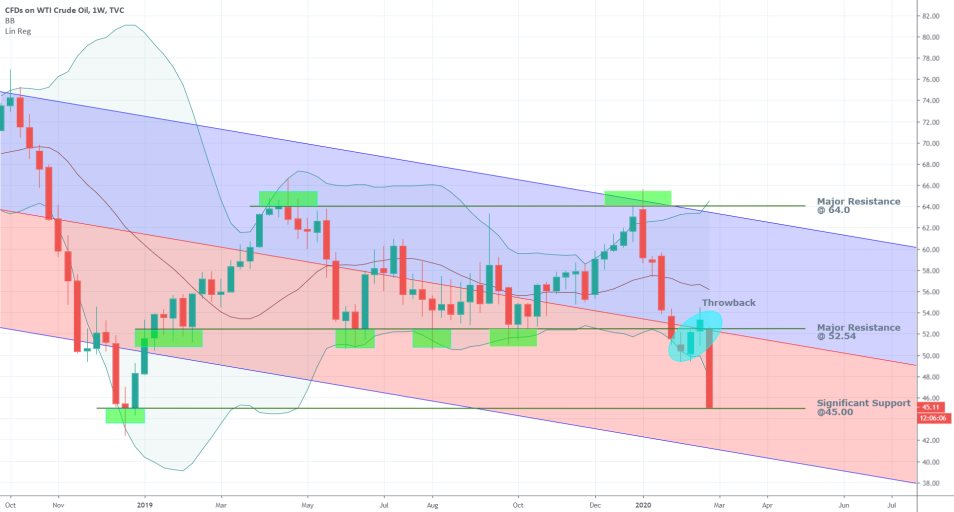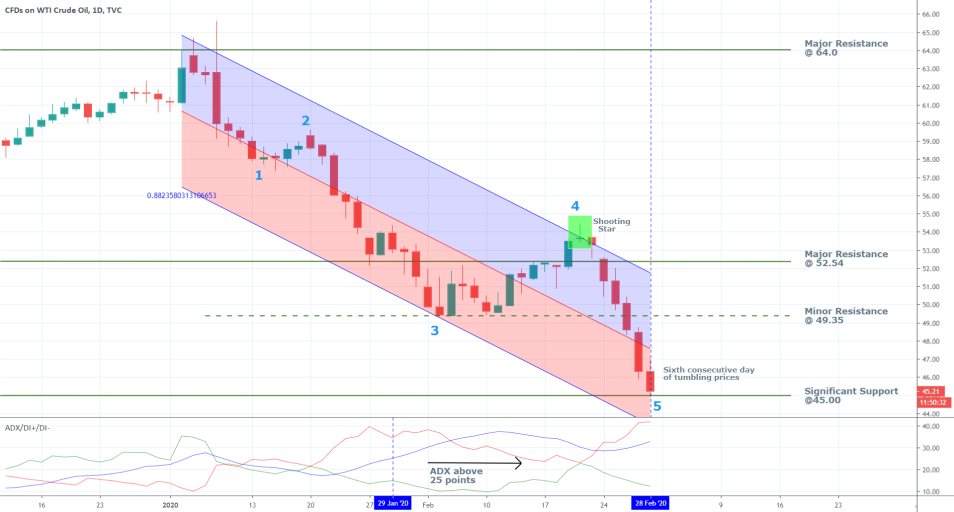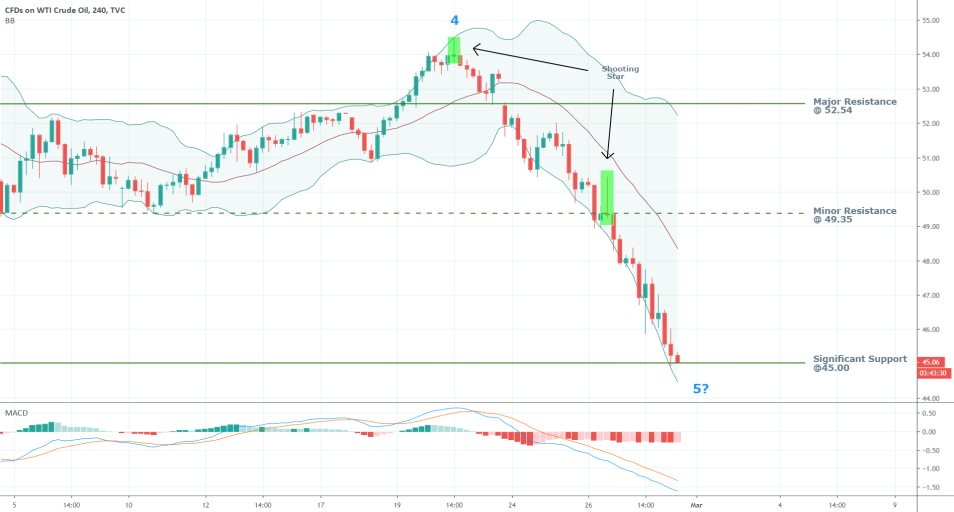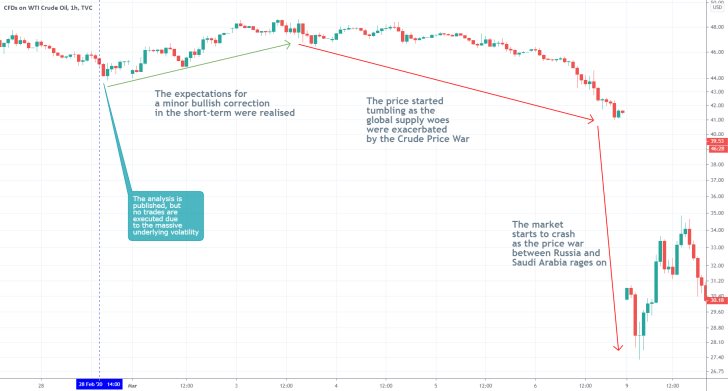The price of the commodity was hit markedly this week by the ongoing global tensions stemming from the spread of the deadly coronavirus outside of China. Global demand was jolted as the industry sectors in China and elsewhere were distorted by the governments-imposed quarantines on whole communities, in a bid to curb the spread of the disease outside of the affected areas. As production in many plants in China remains on momentarily on pause, especially in the most affected Hubei province, the demand for the liquid gold has promptly dwindled.
The beginning of this week marked a profound change in the progression of the coronavirus epidemic, as COVID-19 started to become viral in territories outside of China meaning that global efforts to contain the spread of the virus have so far had minimal effect. The capital markets did not take lightly to the news, as global stocks plummeted in what has now turned into the biggest correction on record. The stock market selloff and the resulting investors’ panic have also extended to the commodities market.
Crude oil has already depreciated by more than seven dollars per barrel in those five trading days, which amounts to nearly fifteen per cent of its value. The price action of the financial instrument has so far followed quite closely the projections of our analysis from the 19th of February (you can read more about it here), which begs the question of how the price action would proceed next. It is nearing the significant support level at 45.00, which could act as a potential turning point for the price action's direction. On the other hand, the current bearish market is underpinned by substantial external pressure owing to the COVID-19 panic, which is likely to persist in the next few weeks and potentially continue to drive the price lower.
That is why the purpose of this analysis is to evaluate those external pressures and the behaviour of the price that was observed during this week’s selloff, in order to project the next most likely development of the crude oil. First of all, however, it should be cautioned against speculative trading in these volatile conditions. The commodity market, in particular, has become especially reactive due to all of the news that comes pouring in almost all the time over the past few days. This has made the price of the crude oil quite responsive to even subtle changes in the underlying trading volume that changes continuously. Therefore, inappropriately timed trade executions, regardless of whether they are inherently contrarian or continuation in nature, would bear significant trading risk under the current market conditions.
1. Long Term Outlook:
The price has expectedly failed to break out above the major resistance level at 52.54 just last week. As we projected in our previous analysis, the intermediate correction had the capacity only to temporarily consolidate below the linear regression's middle line and thereby turn into a throwback. Ultimately, the resistance level coupled with the regression's middle line has amounted to an impenetrable obstacle for the bullish correction, which promptly turned into a substantial bearish downswing this week, as the COVID-19 situation started to worsen.

The price action is currently testing the strength of the significant support level at 45.00, which has been prevalent since December 2018. Optimistic bulls see it as a potential turning point, which could prompt renewed buying pressure and thereby cause a change in the underlying direction of the market. In contrast, bears see it as the final barrier that needs to be broken before the downtrend can resume making monumental gains. If that does indeed happen, the next likely target would be the linear regression's lower boundary, which is currently at around the psychologically significant 40.00 level.
The widening Bollinger Bands (BB) demonstrate the increasing volatility levels, which benefits the bears more because it seems highly unlikely for a reinvigorated bullish sentiment to take place at the current moment. Bears, however, should be cautious of these rising volatility levels, which would make the occasional and adverse fluctuations in the underlying price more probable. This, in turn, would make precise order execution more difficult.
2. What Needs to Happen Before the Momentary Slump in Demand Can Be Terminated?
At the present moment, most significant markets are in free-fall due to the dependence of global economic growth on the international supply chains. Once the business activity in one or more major supply hubs, such as say Honk Kong, are inhibited due to restrictions to travel, the fragility of these supply chains becomes apparent. Even one ripple in the entire network might prove detrimental for the normalization of the processes in this interconnected global economy. In other words, the current markets' selloff is driven by pure speculation, based on investors' fears that the global economy would contract markedly as the international supply chains continue to be distorted.
Such fears extend to the oil market, which continues to suffer from the perceptions of low demand. In reality, however, the industrial demand is not completely demolished, but only temporarily suspended. Thereby, once the market takes into account the newest developments connected to the coronavirus’ spread, the sweeping fears that have grappled the global markets would likely subside.
Media everywhere are currently oversaturated with information connected to COVID-19. This is what is fuelling the conditions for a perfect storm that, in turn, incites the sensationalist mass-market psychology. However, such speculative selloffs typically lack any intrinsic conviction – there is no other reason for a massive selloff to take place now apart from the coronavirus panic. Hence, once this initial shock factor is removed from the picture, there will be nothing left to continue supporting the selloff.
The markets are currently scared mainly from the admission that the virus has become viral outside of China, yet, once this becomes price in, the shock value of the news would be lessened. China actually already set a precedent for what is also likely to occur globally. Once statistics started to show that the number of newly confirmed cases in Wuhan city, the epicentre in the Hubei province, appeared to have surpassed the peak of the outbreak, optimism started returning to the market. That is also likely to happen in Italy, Iran, and elsewhere, once the first signs of improvement start coming in.
The Italian foreign minister Luigi Di Maio actually used the term ‘infodemic' to describe the negative impact of such media oversaturation, which is what incites public fear. According to the BBC:
“Italy's Foreign Minister Luigi Di Maio told reporters that an "infodemic" of misleading news abroad was damaging Italy's economy and reputation.”
In that sense, the temporary slump in oil demand is likely to be terminated as soon as the frenzy settles down.
3. Short Term Outlook:
The ADX is currently threading way above 25 index points, which is illustrative of a very solid trending market, which favours the continuation of the current bearish downswing.
Under Elliott Wave Theory, the price action is currently establishing the fifth and final impulse in a classic 1-5 impulse wave pattern. This means that once a new dip is reached, the price is likely to form a new ABC bullish correction.
The daily chart below confirms the previous assertions from above, that if the bearish downswing manages to break down below the significant support at 45.00 the next most likely target-level would be the regression channel’s lower boundary, which currently stays around the psychologically important 40.00 price level.

The 4H price chart underscores all of the previous observations and highlights the strong bearish momentum in the short term.
The second shooting start candlestick manifests the prevalence of the minor resistance level at 46.35, which is also evident on the daily chart above. Thereby, any new bullish upswing would have to test its strength first before a major new bullish sentiment can be confirmed. The market, however, still looks far away from that.

4. Concluding Remarks:
Arguably, the best thing to do in this volatile environment is to sit and wait to see what happens next. Even joining the current bearish trend involves sizable risk, because even subtle changes in the demand pressures could trigger a bullish correction.
The erratic price action at times is what makes the execution of precise trading orders quite difficult. At any rate, joining the market after the general sentiment quiets down and the panic subsides, is the only sensible thing that can ensure more efficient trading.

- The best thing that the analysis did was to underscore the risks from trading under these volatile conditions. Knowing when and under what terms to place a trading order is, naturally, quite important, but it is even more important to know when to refrain from trading. The key is to know when the risks from the underlying adverse volatility outweigh the potential profits.
- Ultimately, the short-term expectations of the analysis for the formation of a bullish correction were realised, but in this particular scenario the missed opportunity does not weigh down as much on the ultimate performance of the analysis. That is so because the market crash could have taken place sooner rather than later, in which case any bullish orders would have been wiped out in an instant. The big takeaway for traders to remember is that when the market is going through a stretch without a precedent in history, it is better for them to weather the temporary uncertainty by choosing not to trade.
Disclaimer: Your capital is at risk! Trading and investing on the financial markets carries a significant risk of loss. Each material, shown on this website, is provided for educational purposes only. A perfect, 100% accurate method of analysis does not exist. If you make a decision to trade or invest, based on the information from this website, you will be doing it at your own risk. Under no circumstances is Trendsharks responsible for any capital losses or damages you might suffer, while using the company’s products and services. For more information read our Terms & Conditions and Risk Disclaimer.





















